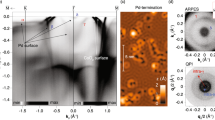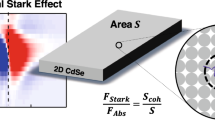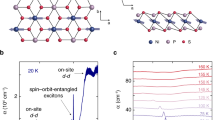Abstract
The surface of nominally diamagnetic colloidal CdSe nanoplatelets can demonstrate paramagnetic behaviour owing to the uncompensated spins of dangling bonds, as we reveal here by optical spectroscopy in high magnetic fields up to 15 T using the exciton spin as a probe of the surface magnetism. The strongly nonlinear magnetic field dependence of the circular polarization of the exciton emission is determined by the magnetization of the dangling-bond spins (DBSs), the exciton spin polarization as well as the spin-dependent recombination of dark excitons. The sign of the exciton–DBS exchange interaction depends on the nanoplatelet growth conditions.
This is a preview of subscription content, access via your institution
Access options
Access Nature and 54 other Nature Portfolio journals
Get Nature+, our best-value online-access subscription
$29.99 / 30 days
cancel any time
Subscribe to this journal
Receive 12 print issues and online access
$259.00 per year
only $21.58 per issue
Buy this article
- Purchase on Springer Link
- Instant access to full article PDF
Prices may be subject to local taxes which are calculated during checkout




Similar content being viewed by others
Data availability
The data on which the plots within this paper are based and other findings of this study are available from the corresponding authors upon justified request.
References
Kovalenko, M. V. et al. Prospects of nanoscience with nanocrystals. ACS Nano 9, 1012–1057 (2015).
Pietryga, J. M. et al. Spectroscopic and device aspects of nanocrystal quantum dots. Chem. Rev. 116, 10513–10622 (2016).
Nasilowski, M., Mahler, B., Lhuillier, E., Ithurria, S. & Dubertret, B. Two-dimensional colloidal nanocrystals. Chem. Rev. 116, 10934–10982 (2016).
Owen, J. The coordination chemistry of nanocrystal surfaces. Science 347, 615–616 (2015).
Drijvers, E., De Roo, J., Martins, J. C., Infante, I. & Hens, Z. Ligand displacement exposes binding site heterogeneity on CdSe nanocrystal surfaces. Chem. Mater. 30, 1178–1186 (2018).
Boles, M. A., Ling, D., Hyeon, T. & Talapin, D. V. The surface science of nanocrystals. Nat. Mater. 15, 141–153 (2016).
Lorenzon, M. et al. Reversed oxygen sensing using colloidal quantum wells towards highly emissive photoresponsive varnishes. Nat. Commun. 6, 6434 (2015).
Owen, J. & Brus, L. Chemical synthesis and luminescence applications of colloidal semiconductor quantum dots. J. Am. Chem. Soc. 139, 10939–10943 (2017).
Singh, S. et al. Colloidal CdSe nanoplatelets, a model for surface chemistry/optoelectronic property relations in semiconductor nanocrystals. J. Am. Chem. Soc. 140, 13292–13300 (2018).
Meerbach, C. et al. Brightly luminescent core/shell nanoplatelets with continuously tunable optical properties. Adv. Opt. Mater. 7, 1801478 (2019).
Ning, Z. et al. Role of surface ligands in optical properties of colloidal CdSe/CdS quantum dots. Phys. Chem. Chem. Phys. 13, 5848–5854 (2011).
Crespo, P. et al. Permanent magnetism, magnetic anisotropy, and hysteresis of thiol-capped gold nanoparticles. Phys. Rev. Lett. 93, 087204 (2004).
Yamamoto, Y. et al. Direct observation of ferromagnetic spin polarization in gold nanoparticles. Phys. Rev. Lett. 93, 116801 (2004).
Meulenberg, R. W. et al. Evidence for ligand-induced paramagnetism in CdSe quantum dots. J. Am. Chem. Soc. 131, 6888–6889 (2009).
Furdyna, J. K. Diluted magnetic semiconductors. J. Appl. Phys. 64, R29–R64 (1988).
Beaulac, R. et al. Spin-polarizable excitonic luminescence in colloidal Mn2+-doped CdSe quantum dots. Nano Lett. 8, 1197–1201 (2008).
Delikanli, S. et al. Mn2+-doped CdSe/CdS core/multishell colloidal quantum wells enabling tunable carrier-dopant exchange interactions. ACS Nano 9, 12473–12479 (2015).
Rodina, A. & Efros, Al. L. Magnetic properties of nonmagnetic nanostructures: dangling bond magnetic polaron in CdSe nanocrystals. Nano Lett. 15, 4214–4222 (2015).
Biadala, L. et al. Magnetic polaron on dangling-bond spins in CdSe colloidal nanocrystals. Nat. Nanotechnol. 12, 569–575 (2017).
Ithurria, S. & Dubertret, B. Quasi 2D colloidal CdSe platelets with thicknesses controlled at the atomic level. J. Am. Chem. Soc. 130, 16504–16505 (2008).
Shornikova, E. V. et al. Addressing the exciton fine structure in colloidal nanocrystals: the case of CdSe nanoplatelets. Nanoscale 10, 646–656 (2018).
Rodina, A. V., Golovatenko, A. A., Shornikova, E. V., Yakovlev, D. R. & Efros, Al. L. Effect of dangling bond spins on the dark exciton recombination and spin polarization in CdSe colloidal nanostructures. J. Electron. Mater. 47, 4338–4344 (2018).
Ithurria, S., Bousquet, G. & Dubertret, B. Continuous transition from 3D to 1D confinement observed during the formation of CdSe nanoplatelets. J. Am. Chem. Soc. 133, 3070–3077 (2011).
Bertrand, G. H. V., Polovitsyn, A., Christodoulou, S., Khana, A. H. & Moreels, I. Shape control of zincblende CdSe nanoplatelets. Chem. Commun. 52, 11975–11978 (2016).
Shornikova, E. V. et al. Electron and hole g-factors and spin dynamics of negatively charged excitons in CdSe/CdS colloidal nanoplatelets with thick shells. Nano Lett. 18, 373–380 (2018).
Cruguel, H. et al. Electronic structure of CdSe-ZnS 2D nanoplatelets. Appl. Phys. Lett. 110, 152103 (2017).
Biadala, L. et al. Recombination dynamics of band edge excitons in quasi-two-dimensional CdSe nanoplatelets. Nano Lett. 14, 1134–1139 (2014).
Efros, Al. L. et al. Band-edge exciton in quantum dots of semiconductors with a degenerate valence band: dark and bright exciton states. Phys. Rev. B 54, 4843–4856 (1996).
Rodina, A. V. & Efros, Al. L. Radiative recombination from dark excitons: activation mechanisms and polarization properties. Phys. Rev. B 93, 155427 (2016).
Johnston-Halperin, E. et al. Spin spectroscopy of dark excitons in CdSe quantum dots to 60 T. Phys. Rev. B 63, 205309 (2001).
Furis, M., Hollingsworth, J. A., Klimov, V. I. & Crooker, S. A. Time- and polarization-resolved optical spectroscopy of colloidal CdSe nanocrystal quantum dots in high magnetic fields. J. Phys. Chem. B 109, 15332 (2005).
Turyanska, L. et al. Photoluminescence of PbS nanocrystals at high magnetic fields up to 30 T. Phys. Rev. B 82, 193302 (2010).
Liu, F. et al. Spin dynamics of negatively charged excitons in CdSe/CdS colloidal nanocrystals. Phys. Rev. B 88, 035302 (2013).
Siebers, B. et al. Exciton spin dynamics and photoluminescence polarization of CdSe/CdS dot-in-rod nanocrystals in high magnetic fields. Phys. Rev. B 91, 155304 (2015).
Wojtowicz, T. et al. g-factor dependence of the evolution of magneto-optical spectra with the density of quasi-two-dimensional electrons in Cd1−xMnxTe/Cd1−yMgyTe heterostructures. Phys. Rev. B 59, R10437–R10440 (1999).
Ditina, Z. Z. & Strakhov, L. P. Investigation of surface of cadmium selenide by EPR method. Sov. Phys. Solid State 9, 2000–2003 (1968).
Li, Z. & Peng, X. Size/shape-controlled synthesis of colloidal CdSe quantum disks: ligand and temperature effects. J. Am. Chem. Soc. 133, 6578–6586 (2011).
Rodina, A. V., Golovatenko, A. A., Shornikova, E. V. & Yakovlev, D. R. Spin physics of excitons in colloidal nanocrystals. Phys. Solid State 60, 1537–1553 (2018).
Kudlacik, D. et al. Single and double electron spin-flip Raman scattering in CdSe colloidal nanoplatelets. Nano Lett. 20, 517–525 (2020).
Guzelturk, B., Erdem, O., Olutas, M., Kelestemur, Y. & Demir, H. V. Stacking in colloidal nanoplatelets: tuning excitonic properties. ACS Nano 8, 12524–12533 (2014).
Tessier, M. D. et al. Phonon line emission revealed by self-assembly of colloidal nanoplatelets. ACS Nano 7, 3332–3340 (2013).
Rowland, C. E. et al. Picosecond energy transfer and multiexciton transfer outpaces Auger recombination in binary CdSe nanoplatelet solids. Nat. Mater. 14, 484–489 (2015).
Tessier, M. D., Javaux, C., Maksimovic, I., Loriette, V. & Dubertret, B. Spectroscopy of single CdSe nanoplatelets. ACS Nano 6, 6751–6758 (2012).
Kunneman, L. T. et al. Nature and decay pathways of photoexcited states in CdSe and CdSe/CdS nanoplatelets. Nano Lett. 14, 7039–7045 (2014).
Olutas, M. et al. Lateral size-dependent spontaneous and stimulated emission properties in colloidal CdSe nanoplatelets. ACS Nano 9, 5041–5050 (2015).
Lepine, D. J. Spin-dependent recombination on silicon surface. Phys. Rev. B 6, 436–441 (1972).
Paget, D. Optical-pumping study of spin-dependent recombination in GaAs. Phys. Rev. B 30, 931–946 (1984).
Weisbush, C. & Lampel, G. Spin-dependent recombination and optical spin orientation in semiconductors. Solid State Commun. 14, 141–144 (1974).
Acknowledgements
We are thankful to Al. L. Efros and Yu. G. Kusrayev for fruitful discussions. We acknowledge the financial support by the Deutsche Forschungsgemeinschaft through the International Collaborative Research Centre TRR160 (Project B1), the Russian Foundation for Basic Research (grant no. 19-52-12064 NNIO-a). A.V.R. acknowledges partial support of the Russian Foundation for Basic Research (grant no. 17-02-01063). A.A.G. acknowledges support of the Grants Council of the President of the Russian Federation. A.P. and I.M. acknowledge funding from the European Research Council (ERC) under the European Union’s Horizon 2020 research and innovation programme (grant agreement no. 714876 PHOCONA).
Author information
Authors and Affiliations
Contributions
E.V.S., L.B. and G.Q. performed the measurements under the guidance of D.R.Y. and M.B. A.A.G. performed theoretical modelling of the experimental data under the guidance of A.V.R. E.V.S., A.A.G., A.V.R. and D.R.Y. analysed and interpreted the data. A.K. and M.N. synthesized the nanocrystals (Samples 1, 3 and 4) under the guidance of B.D., and A.P. synthesized nanocrystals (Samples 2 and 5) under the guidance of I.M. E.V.S., A.A.G., A.V.R. and D.R.Y. wrote the manuscript with the assistance of all other co-authors.
Corresponding authors
Ethics declarations
Competing interests
The authors declare no competing interests.
Additional information
Peer review information Nature Nanotechnology thanks Mikhail Artemyev and the other, anonymous, reviewer(s) for their contribution to the peer review of this work.
Publisher’s note Springer Nature remains neutral with regard to jurisdictional claims in published maps and institutional affiliations.
Supplementary information
Supplementary Information
Supplementary Figs. 1–12, Sections 1–5 (additional experimental results, additional theory) and Table 1.
Rights and permissions
About this article
Cite this article
Shornikova, E.V., Golovatenko, A.A., Yakovlev, D.R. et al. Surface spin magnetism controls the polarized exciton emission from CdSe nanoplatelets. Nat. Nanotechnol. 15, 277–282 (2020). https://doi.org/10.1038/s41565-019-0631-7
Received:
Accepted:
Published:
Issue Date:
DOI: https://doi.org/10.1038/s41565-019-0631-7
This article is cited by
-
The point defect and electronic structure of K doped LaCo0.9Fe0.1O3 perovskite with enhanced microwave absorbing ability
Nano Research (2022)
-
Manganese doping for enhanced magnetic brightening and circular polarization control of dark excitons in paramagnetic layered hybrid metal-halide perovskites
Nature Communications (2021)
-
2D Cadmium Chalcogenides for Optoelectronics
Chemical Research in Chinese Universities (2020)



